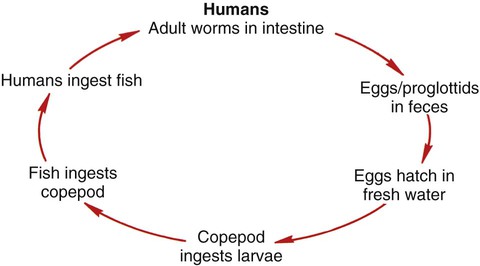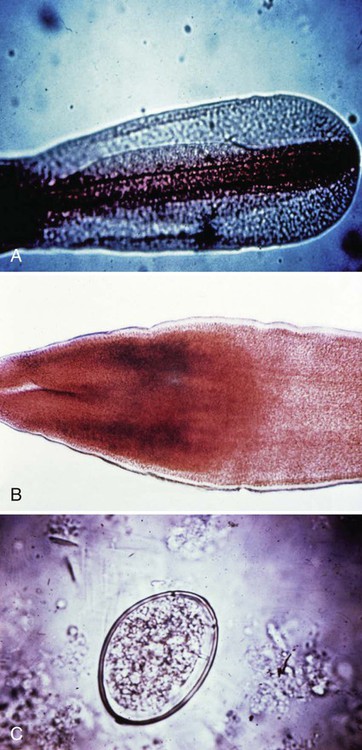Intestinal Cestodes
1. Describe the distinguishing morphologic characteristics, clinical disease, basic life cycle (vectors, hosts, and stages of infectivity), and laboratory diagnosis for the intestinal cestodes included in this chapter.
2. Define and identify (where appropriate) the following parasitic structures: scolex, proglottids, rostellum, hermaphroditic, oncosphere, hexacanth embryo, strobila, bothria, and coracidium.
3. Compare and contrast autoinfection and hyperinfection.
4. List several methods of control and prevention of tapeworm infection.
5. Correlate the life cycles with the specific diagnostic stage(s) for each organism.
The intestinal cestodes are commonly referred to as tapeworms. Tapeworms have a long, segmented, ribbonlike body with a specialized structure for attachment, or scolex, at the anterior end. The adult tapeworm consists of a chain of egg-producing units called proglottids, which develop posteriorly from the neck region of the scolex. The crown of the scolex, rostellum, may be smooth or armed with hooks. The body of the worm (proglottids) varies in the geometric characteristics or number of segments according to the genus and species of the cestode. The mature cestode is hermaphroditic. In other words, the organism contains both male and female reproductive organs. Food is absorbed from the host through the worm’s integument, the outer covering or skin of the organism. Adult worms typically inhabit the small intestine; however, humans may be host to either the adult or the larval forms, depending on the infecting species. Humans infected with a cestode pass the eggs in the feces. The embryo may be visible within the tapeworm egg as an oncosphere (larva tapeworm within an embryonic envelope, infective stage) or hexacanth embryo. The intermediate host ingests feces containing the adult tapeworm eggs, which further develop into the larva of the cestode. Cestodes generally require one or more intermediate hosts for the completion of their life cycle. Intestinal tapeworm infections are generally asymptomatic. However, if the larval stage develops in human organs outside the intestine, they may cause additional life-threatening complications. Serologic tests are not available for the diagnosis of tapeworm infections, therefore requiring skilled laboratorians for proper morphologic identification of the organism. Fresh or preserved stools are the specimen of choice for ova and parasites (O&P) examination and cestode identification. Preserved stool containing adult worm segments (strobila) or the scolex may also be used for diagnosis. Chapter 47 describes the methods and specimen requirements in more detail as they relate to parasitology. This chapter describes the intestinal cestodes of public health importance.
Diphyllobothrium Latum
General Characteristics
Diphyllobothrium latum, the freshwater broad fish tapeworm, is the largest human tapeworm. Adults have been known to reach up to 10 m in length, with more than 3000 to 4000 proglottids, and reside within a host for 30 years or more. The proglottids are characteristically wider than long with a central rosette-shaped uterine structure (Figure 54-1). The scolex is spatulate and contains two shallow sucking grooves referred to as bothria (Figure 54-1, B). D. latum has unembryonated eggs. The eggs are operculated with a terminal knob, similar to trematode eggs (Figure 54-1, C). The intermediate hosts include crustaceans and freshwater fish.
Pathogenesis and Spectrum of Disease
Diphyllobothrium latum is the only cestode to have an aquatic life cycle (Figure 54-2). Fish serve as the reservoir host, with humans serving as the definitive host. D. latum eggs are found in the feces of infected humans and other fish-eating mammals. Once passed into a water source, such as a lake, the life cycle requires two intermediate hosts. After incubation in freshwater for approximately 2 weeks, the mature eggs release the first larval stage (coracidium). The coracidia are ingested by copepods. The fish feed upon the small crustaceans ingesting the procercoid larvae. Within the freshwater fish, the larvae develop into the infective larvae. D. latum infection occurs through the ingestion of poorly cooked freshwater fish containing the plerocercoid larval form. D. latum matures to an adult tapeworm within the human small intestine. Infection is usually asymptomatic, but mild gastrointestinal symptoms may occur such as diarrhea, abdominal pain, fatigue, vomiting, or dizziness. Symptoms vary depending on the worm burden and the host’s immune response to the organism. The tapeworm nutritional requirements may decrease the host’s vitamin B12 level, resulting in megaloblastic anemia (Table 54-1).
TABLE 54-1
Epidemiology of the Intestinal Cestodes That Cause Disease in Humans
| Parasite | Habitat (Reservoir) | Mode of Transmission |
| Diphyllobothrium latum | Adult tapeworms can be found in a number of wild animals, the most important being dogs, bears, seals, and walrus, that serve as reservoir hosts; the human serves as the definitive host. | Occurs via ingestion of poorly cooked freshwater fish containing the sparganum or plerocercoid larval form. |
| Dipylidium caninum | Humans serve as an accidental host for the dog tapeworm. Dogs, cats, and wild animals serve as a reservoir host. Arthropods such as the dog and cat flea serve as an intermediate host. | Transmitted to humans through the ingestion of dog/cat fleas. |
| Hymenolepis nana | The dwarf tapeworm can also occur in rodents; the human can serve as both intermediate and definitive host, with development from the egg to adult worm occurring in the human intestine. | Primarily acquired from accidental ingestion of eggs from an adult tapeworm, most commonly via fecal-oral exposure. |
| Hymenolepis diminuta | The rat tapeworm frequently infects rodents, and rarely infects humans. | Infects humans after infected mice and rats contaminate food with their feces. |
| Taenia solium | Humans serve as the definitive host for the pork tapeworm, whereas pigs and humans serve as intermediate hosts. | Humans become infected when cyst-infected pork is ingested. |
| Taenia saginata | Humans serve as the definitive host for the beef tapeworm, whereas cows/camels serve as intermediate hosts. | Humans become infected when cyst-infected beef is ingested. |

Laboratory Diagnosis
Both eggs and proglottids may be found in patient’s feces. Visualization of the eggs is enhanced using a wet preparation of the patient’s stool sample. Diagnosis is made by identification of the ovoid, operculated, yellow-brown eggs (58 to 75 µm by 40 to 50 µm) passed in abundance in the stool. They are sometimes confused with the eggs of Paragonimus. The mature gravid proglottids are wider than long (3 × 11 mm), often in chains, and contain a rosette-shaped central uterus (Figure 54-3). Species identification is through assessment of the morphologic characteristics of the proglottids as previously described (Tables 54-2 and 54-3).
TABLE 54-2
Common Human Parasites, Diagnostic Specimens, Tests, and Positive Findings
| Organism | Acquire Infection from: | Location in Host | Diagnostic Specimen | Diagnostic Test* | Positive Specimen | Comments |
| Intestinal cestodes Taenia saginata (beef) |
Ingestion of raw beef | Intestine | Stool and/or proglottids | O&P, India ink proglottids | Eggs, proglottid branches | Both Taenia eggs look alike; need gravid proglottid or scolex for definitive identification. |
| Taenia solium (pork) | Ingestion of raw pork | Stool and/or proglottids | O&P, India ink proglottids | Eggs, proglottid branches | ||
| Diphyllobothrium latum | Ingestion of raw freshwater fish | Stool and/or proglottids | O&P | Eggs, proglottid shape | ||
| Hymenolepis nana | Tapeworm eggs | Stool | O&P | Eggs | ||
| Hymenolepis diminuta | Grain beetles | Stool | O&P | Eggs | ||
| Dipylidium caninum | Fleas from dogs/cats | Stool and/or proglottids | O&P | Eggs, proglottid shape |

*Although serologic tests are not always mentioned, they are available for a number of parasitic infections. Unfortunately, most are not routinely available. Contact your state public health laboratory or the Centers for Disease Control and Prevention in Atlanta, Georgia.
TABLE 54-3
Cestode Parasites of Humans (Intestinal)
| Diphyllobothrium latum | Taenia saginata | Taenia solium | Hymenolepis nana | Hymenolepis diminuta | Dipylidium caninum | |
| Intermediate hosts (common) | Two: copepods and fish | One: cattle | One: pig | One: various arthropods (beetles, fleas); or none | One: various arthropods (beetles, fleas) | One: various arthropods (fleas, dog lice) |
| Mode of infection | Ingestion of plerocercoid (sparganum) in flesh of infected fish | Ingestion of cysticercus in infected beef | Ingestion of cysticercus in infected pork | Ingestion of cysticercoid in infected arthropod or by direct ingestion of egg; autoinfection may also occur | Ingestion of cysticercoid in infected arthropod | Ingestion of cysticercoid in fleas, lice |
| Prepatent period | 3-5 weeks | 10-12 weeks | 5-12 weeks | 2-3 weeks | ≈3 weeks | 3-4 weeks |
| Normal life span | Up to 25 years | Up to 25 years | Up to 25 years | Perhaps many years as a result of autoinfection | Usually <1 year | Usually <1 year |
| Length | 4-10 m | 4-12 m | 1.5-8 m | 2.5-4.0 cm | 20-60 cm | 10-70 cm |
| Scolex | Spatulate, 3 × 1 mm; no rostellum or hooklets; has 2 shallow grooves (bothria) | Quadrate, 1-2 mm in diameter; no rostellum or hooklets; 4 suckers | Quadrate, 1-mm diameter; has rostellum and hooklets; 4 suckers | Knoblike but not usually seen; has rostellum and hooklets; 4 suckers | Knoblike but not usually seen; has rostellum but no hooklets; 4 suckers | 0.2-0.5 mm in diameter; has conical/retractile rostellum armed with 4-7 rows of small hooklets; 4 suckers |








